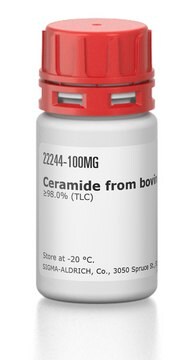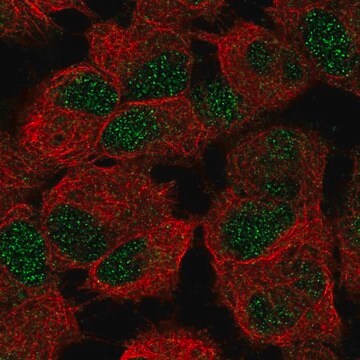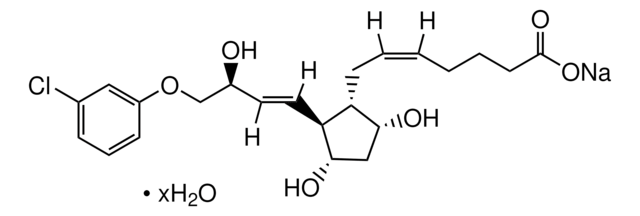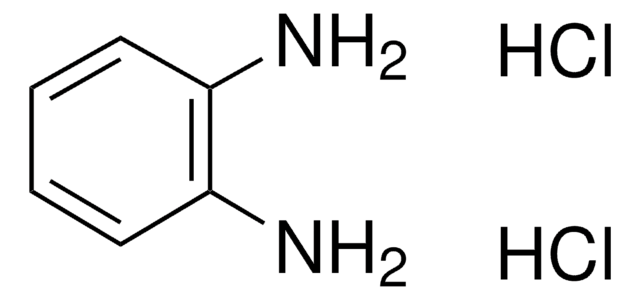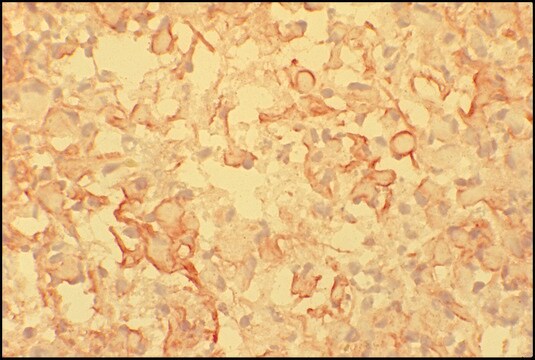C8104
Monoclonal Anti-Ceramide antibody produced in mouse
clone MID 15B4, purified immunoglobulin, buffered aqueous solution
Synonym(s):
Ceramide Antibody, Ceramide Antibody - Monoclonal Anti-Ceramide antibody produced in mouse
Sign Into View Organizational & Contract Pricing
All Photos(1)
About This Item
Recommended Products
biological source
mouse
Quality Level
conjugate
unconjugated
antibody form
purified immunoglobulin
antibody product type
primary antibodies
clone
MID 15B4, monoclonal
form
buffered aqueous solution
technique(s)
immunohistochemistry (frozen sections): suitable
indirect ELISA: 1:10
isotype
IgM
shipped in
wet ice
storage temp.
2-8°C
target post-translational modification
unmodified
Related Categories
General description
Ceramide is an endogenous lipid component of a novel biochemical pathway termed the sphingomyelin pathway. Ceramide is produced in response to cellular stimulation by hormones, cytokines and antigens. Ceramide synthesis is mediated either by the salvage pathway by the acylation of sphingosine or sphingolipids hydrolysis or by de novo pathway via dihydroceramide formation. Structurally, ceramides have a sphingoid base, a long-chain amino alcohol linked to fatty acid by an amide bond. Ceramide is generated by hydrolysis of sphingomyelin by sphingomyelinase.
Specificity
Mouse monoclonal clone MID 15B4 anti-Ceramide antibody recognizes free and bound ceramides.
Immunogen
ceramide conjugated to bovine serum albumin.
Application
Monoclonal Anti-Ceramide antibody produced in mouse has been used in:
- immunohistochemistry
- immunolabeling in electron microscopy
- enzyme-linked immunosorbent assay (ELISA)
- immunoblotting
- immunoprecipitation
- as a probe to determine the presence and roles of ceramide in sphingomyelin pathway signaling and the regulation of protein phosphorylation.
Biochem/physiol Actions
Ceramide appears to have a role in mediating biological responses in a wide variety of cell types. Ceramide metabolites such as sphingosine and sphingosine-1-phosphate have potent biological activities of their own. They are directly involved in the proliferation and differentiation of skin cells and regulate skin barrier functionality. Ceramide based analogs are potential anti-tumor agents and are regarded as tumor suppressor lipid. Mechanisms for ceramide action involve regulation of protein phosphorylation via stimulation of a serine/threonine protein phosphatase, a proline-directed kinase and possibly other direct and/or indirect targets. Ceramide is emerging as an intracellular messenger than mediates effects on terminal differentiation and cell proliferation as well as apoptosis or cell death and cell-cycle arrest. The interrelationship of ceramide actions with other bioactive lipids and systems represents an area of active research.
Physical form
Solution in phosphate buffered saline containing 0.5 M NaCl, 0.1% bovine serum albumin, and 0.09% sodium azide.
Preparation Note
Purified from ascites fluid by gel filtration using sephacryl S-300 resin.
Analysis Note
The antibody was characterized on ceramide covalently bound to myoglobin.
Disclaimer
Unless otherwise stated in our catalog or other company documentation accompanying the product(s), our products are intended for research use only and are not to be used for any other purpose, which includes but is not limited to, unauthorized commercial uses, in vitro diagnostic uses, ex vivo or in vivo therapeutic uses or any type of consumption or application to humans or animals.
Not finding the right product?
Try our Product Selector Tool.
Storage Class Code
10 - Combustible liquids
Flash Point(F)
Not applicable
Flash Point(C)
Not applicable
Choose from one of the most recent versions:
Already Own This Product?
Find documentation for the products that you have recently purchased in the Document Library.
Customers Also Viewed
ELOVL4-mediated production of very long-chain ceramides stabilizes tight junctions and prevents diabetes-induced retinal vascular permeability
Kady NM, et al.
Diabetes, 67(4), 769-781 (2018)
Ignazio Restivo et al.
International journal of molecular sciences, 24(2) (2023-01-22)
Cell death program of red blood cells (RBCs), called eryptosis, is characterized by activation of caspases and scrambling of membrane phospholipids with externalization of phosphatidylserine (PS). Excessive eryptosis confers a procoagulant phenotype and is implicated in impairment of microcirculation and
Insulin resistance, ceramide accumulation, and endoplasmic reticulum stress in human chronic alcohol-related liver disease
Longato L, et al.
Oxidative Medicine and Cellular Longevity, 2012 (2012)
Role of sphingomyelinase in mitochondrial ceramide accumulation during reperfusion
Ramirez-Camacho I, et al.
Biochimica et Biophysica Acta (BBA)-Molecular Basis of Disease, 1862(10), 1955-1963 (2016)
The sphingolipid salvage pathway in ceramide metabolism and signaling
Kitatani K, et al.
Cellular Signalling, 20(6), 1010-1018 (2008)
Our team of scientists has experience in all areas of research including Life Science, Material Science, Chemical Synthesis, Chromatography, Analytical and many others.
Contact Technical Service